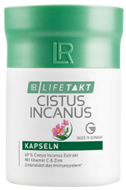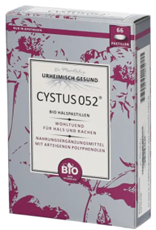Damage caused by defects in ‘suggestive’ mark – CYSTUS
The case: Since the 1980s, Dr Pandalis had been working with the medicinal plant Cistus incanus, also known as cistus. He was the first to bring products containing the active ingredients of this plant onto the market, one such product being organic throat tablets. He invented a so-called ‘suggestive’ mark for his products. This was registered for him as a Union trade mark in 2004 for ‘non-medicinal food supplements’:
![]()
A competitor, LR Health & Beauty Systems GmbH, produces food supplements containing extract of cistus. It markets these products as follows:

In 2013, LR Health & Beauty Systems applied to the European Union Intellectual Property Office for cancellation of the CYSTUS trade mark on the grounds of non-use. For the uninterrupted period of five years prior to the filing of the application, they claimed the mark had only been used to describe the ingredient of the products, and that this did not constitute use as a trade mark.
Dr Pandalis strongly objected. Among other things, he referred to the use of the CYSTUS trade mark with the registration symbol ® on the following packaging:

His defence, however, was in vain. The European Court of Justice gave a number of significant reasons as to why the argument for non-use succeeded.
The trade mark was essentially only a designation of an active ingredient and it lacked the necessary distinctive character to be regarded as use of a trade mark. On the packaging, CYSTUS indicated only that the tablets contained the active ingredient of the plant cistus, and this did not constitute use as a trade mark. ‘CYSTUS’ did not indicate that the tablets came from Dr Pandalis.
The incorrect spelling of the active ingredient with a ‘Y’ did not alter the situation. The plant name cistus was still sufficiently recognisable.
Another argument in favour of the trade mark CYSTUS not having been used was the distinctive addition ‘052’. It was considered that this created a completely different designation, namely CYSTUS 052, with the characteristic element of this new designation being ‘052’ and not ‘CYSTUS’.
The registration symbol ‘®’ next to CYSTUS 052 on the packaging was of no help either with respect to non-use. It is true that a registration symbol indicates that a designation has been registered as a trade mark. However, it did not follow from this that a sign had the necessary distinctive character to be regarded as use of a trade mark.
If that were not enough, another fundamental error was identified for the ‘suggestive’ mark. CYSTUS was only registered for food supplements. However, it was not used for this. Food supplements are foodstuffs containing certain nutrients. The throat tablets marketed under CYSTUS were in fact medicinal products. They contained a central pharmaceutical number, they were sold in pharmacies and they were marketed by referring to benefits such as protection against infections and a corresponding healing function.
As a result, the CYSTUS trade mark was cancelled for ‘non-medical food supplements’.
ECJ of 31. 01. 2019, C-194/17 P; ECJ of 14. February 2017, ‑T15/16.
Learnings: Avoid fundamental errors when building a brand at the outset. The brand must not only reflect product characteristics. Slight variations in spelling are not a way to overcome this deficiency. The trade mark must also be registered for all products and services for which you will later use it. Avoid mistakes in the later use of the trade mark – a modified use of it can only continue to represent the use of the trade mark if the modification does not change its distinctive character. Do not rely on the registration symbol ‘®’ as it cannot compensate for other fundamental deficiencies implicit in your trade mark.
Reference: You might also wish to read this article on genuine use: